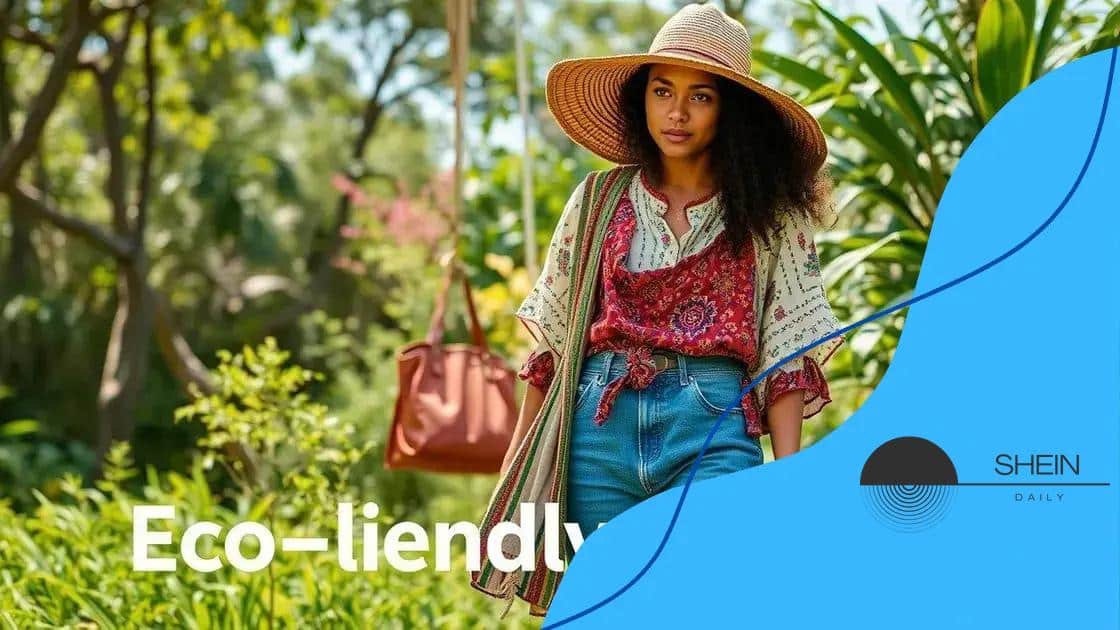Shein’s sustainability initiatives update 2025

Shein’s sustainability initiatives focus on using eco-friendly materials and increasing transparency, but the brand faces challenges in balancing fast production demands with environmental responsibility and meeting consumer expectations for accountability.
Shein’s sustainability initiatives update 2025 highlights the fashion giant’s ongoing commitment to eco-friendly practices. Curious about how they’re addressing environmental concerns? Let’s dive into the latest developments and what they mean for you and the planet.
An overview of Shein’s sustainability goals
Understanding Shein’s sustainability goals is crucial as we navigate a world increasingly focused on environmental responsibility. The brand has made significant promises to reduce its ecological footprint while maintaining its presence in the fast fashion industry.
At the heart of Shein’s approach is a commitment to using more sustainable materials. This includes transitioning to fabrics made from recycled and organic sources, which not only reduces waste but also lessens the brand’s overall impact on the environment.
Key Initiatives in Sustainable Practices
Some of the notable initiatives that Shein has implemented are:
- Investing in eco-friendly production techniques
- Implementing a recycling program for old clothing
- Partnering with organizations that promote sustainable fashion
This multi-faceted approach aims to tackle various aspects of sustainability, ensuring that Shein not only focuses on the present but also on long-term solutions.
Another crucial aspect of Shein’s sustainability goals is transparency. The brand has started publishing information about its supply chain, allowing consumers to understand where and how their clothes are made. This initiative fosters trust, encouraging customers to make informed choices. As consumers become more environmentally conscious, such transparency is essential to build brand loyalty.
Future Challenges
Despite the advancements, challenges remain. Competing in the fast fashion market while maintaining sustainability is a delicate balance. As demand for quick, affordable fashion persists, Shein must find innovative ways to meet consumer expectations without compromising its sustainability commitments.
By continuing to innovate and adapt, Shein strives to align with global sustainability standards. The journey is ongoing, and every step taken is crucial for the planet’s future.
Recent advancements in eco-friendly materials
As companies aim to enhance their sustainability, recent advancements in eco-friendly materials have become a focal point in the fashion industry. These innovations not only aim to reduce environmental impact but also cater to the growing demand for responsible consumption.
One prominent trend is the development of materials made from recycled plastics. Brands are now transforming plastic waste into fashionable garments, reducing reliance on virgin resources. This process not only minimizes waste but also promotes a circular economy.
Innovative Natural Fibers
Alongside recycled materials, there has been a surge in the use of natural fibers sourced from sustainable practices. These include:
- Organic cotton: Grown without harmful pesticides or fertilizers.
- Bamboo: A rapidly renewable resource that requires less water.
- Hemp: Known for its durability and low environmental impact.
Each of these materials not only provides an eco-friendly alternative but also supports the health of the planet.
Furthermore, advancements in textile technology have led to the creation of materials that are biodegradable. This innovation allows clothes to break down naturally, reducing pollution and landfill waste. Manufacturers are increasingly exploring ways to incorporate these biodegradable materials into their products.
Impact on Consumer Choices
With these advancements, consumers now have more options than ever to make sustainable choices. Eco-conscious shoppers are more likely to support brands that prioritize environmentally friendly materials. This shift drives companies to adopt more responsible practices, influencing the entire industry.
In conclusion, recent advancements in eco-friendly materials signify a meaningful step towards a more sustainable future in fashion. As brands innovate and consumers demand transparency, the industry is evolving. The goal is not just to create stylish apparel but to do so in a way that is respectful to our planet.
Impact of Shein’s initiatives on the fashion industry

The impact of Shein’s initiatives on the fashion industry is significant, as the brand sets a precedent for other companies in the sector. As Shein implements sustainable practices, it influences consumer behavior and challenges traditional fast fashion norms.
One major change is the shift towards transparency. Brands are now expected to disclose their sustainability efforts and supply chain practices. This increased scrutiny impacts not only Shein but also competitors who must improve their practices to remain relevant.
Shaping Consumer Expectations
Shein’s initiatives encourage consumers to demand more sustainable options from all fashion retailers. This evolving consumer mindset can result in:
- Increased demand for eco-friendly products: Shoppers are more likely to choose brands that focus on sustainability.
- Accountability: Brands face pressure to become accountable for their environmental policies.
- Collaboration: Increased partnerships between brands and sustainability organizations to promote better practices.
This transformation in consumer expectations is reshaping how companies approach their environmental impact.
Additionally, Shein’s use of social media advertising has revolutionized marketing strategies in fashion. The brand effectively utilizes influencers and targeted ads to reach younger audiences. This approach not only drives sales but also spreads awareness about sustainability.
Driving Industry Standards
As shein leads the charge, other brands are adapting by adopting sustainable materials and processes. The ripple effect is evident in how many companies are now prioritizing their environmental footprints. They are revising their production methods to include less waste and more sustainable materials.
Moreover, Shein’s success illustrates that sustainability can coexist with profitability. This realization demonstrates that eco-conscious choices can be appealing to consumers without sacrificing style. As a result, the entire fashion industry is beginning to rethink its goals and methods.
Consumer response to Shein’s sustainability efforts
The consumer response to Shein’s sustainability efforts has been mixed, reflecting a broad spectrum of opinions on fast fashion and environmental responsibility. As Shein adopts new sustainable practices, customers are paying closer attention to their choices and the impact on the environment.
Many consumers are expressing their approval of Shein’s initiatives, appreciating the push toward more eco-friendly materials and production methods. This aligns with a growing trend among shoppers who prioritize sustainability in their purchasing decisions.
Positive Feedback from Eco-Conscious Shoppers
Some key factors driving positive consumer responses include:
- Transparency: Shein’s efforts to disclose their sustainability initiatives enhance trust.
- Access to sustainable fashion: Customers find it easier to make environmentally friendly choices with Shein’s offerings.
- Social media awareness: Influencers promoting Shein’s sustainable practices reach younger audiences effectively.
These elements contribute to a favorable image for the brand as it works to create a more responsible fashion model.
However, not all feedback has been positive. Concerns remain about the overall impact of fast fashion. Critics argue that despite Shein’s sustainability promises, the brand’s rapid production cycle and high volume of output pose ongoing environmental challenges. Shoppers are increasingly vocal about the need for brands to balance profit with ecological impact.
Shifting Consumer Expectations
As discussions around sustainability grow, consumer expectations are evolving. Many now demand more than just marketing promises. They expect action and results from brands like Shein. Here are some emerging consumer demands:
- Accountability in practices: Customers want brands to show measurable results in their sustainability efforts.
- Longer-lasting products: Demand for quality over quantity as shoppers seek durability in their fashion choices.
- Real change: There’s a call for brands to invest in long-term sustainable solutions rather than quick fixes.
This shift signifies a new era of consumer engagement, where individuals are more informed and willing to hold brands accountable.
Future challenges for Shein’s sustainability plans
The future challenges for Shein’s sustainability plans are multifaceted, as the brand navigates the complexities of the fast fashion industry. Despite significant strides towards sustainable practices, several hurdles remain that could impact its trajectory.
One of the primary challenges is maintaining a balance between growth and sustainability. As a leading fast fashion retailer, Shein faces pressure to produce new styles rapidly. This speed can conflict with sustainable production practices, making it difficult to implement eco-friendly solutions consistently.
Consumer Awareness and Expectations
Another challenge is navigating increasing consumer awareness regarding sustainability. Shoppers are now more informed and critical of brands. They demand transparency and accountability, which requires Shein to provide concrete evidence of its sustainability claims. Key factors influencing consumer expectations include:
- Authenticity: Customers want real change, not just marketing tactics.
- Traceability: There is a growing need for brands to show where and how products are made.
- End-of-life solutions: Consumers are looking for options to recycle or dispose of products environmentally.
These expectations put pressure on Shein to consistently evolve and improve its sustainability practices.
Additionally, the brand must find ways to innovate sustainably. Technologies for eco-friendly materials and production methods are continuously advancing. Staying ahead of these innovations is essential for Shein to keep its competitive edge while fulfilling sustainability goals.
Regulatory Compliance
Regulatory landscapes are also shifting, as governments and organizations are implementing stricter sustainability regulations. Shein must adapt quickly to these changes, which may require significant adjustments in its operations and supply chain management.
Lastly, addressing the environmental impact of logistics and distribution poses a significant challenge. As Shein scales its operations, assessing carbon footprints and finding greener delivery methods becomes increasingly important. The logistics sector remains a key contributor to global emissions, and Shein must prioritize this aspect of its sustainability efforts.
In conclusion, Shein’s sustainability journey is full of potential and challenges. As the brand embraces eco-friendly practices, it influences the fashion industry to shift towards better practices. However, there are hurdles to overcome, such as balancing rapid production with responsible sourcing and addressing consumer demands for transparency. By continuing to innovate and adapt, Shein can make a significant positive impact on the environment and inspire change in the fast fashion sector.
FAQ – Frequently Asked Questions about Shein’s Sustainability Efforts
What are Shein’s main sustainability initiatives?
Shein focuses on using eco-friendly materials, improving transparency in its supply chain, and implementing recycling programs.
How do consumers respond to Shein’s sustainability efforts?
Consumers have mixed responses, with many appreciating the initiatives but also demanding more transparency and accountability.
What challenges does Shein face in maintaining sustainability?
Key challenges include balancing rapid production with sustainable practices, adapting to regulatory changes, and addressing consumer demands.
How can consumers support Shein’s sustainability goals?
Consumers can support these goals by making informed purchasing decisions, advocating for transparency, and choosing eco-friendly options.





